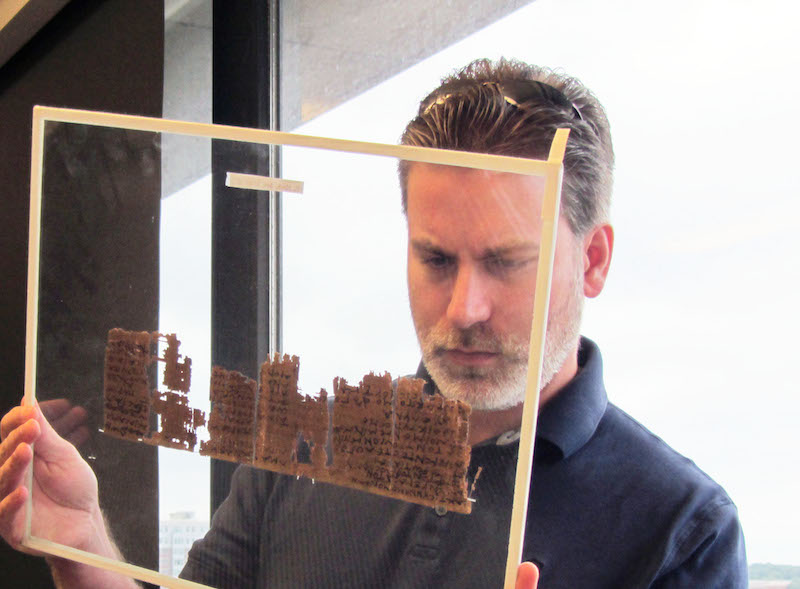
Michael Sampson examines a papyri in the University of Michigan's collection // Photo: Monica Tsuneishi (archive)
The Guardian: The curious case of the stolen gospel
In a tale worthy of a Dan Brown novel, The Guardian newspaper examines the scandal involving a classics professor at Oxford University. Reporter Charolette Higgins’s lengthy article reveals the strange ties between the Oxford don, billionaires, and ancient manuscripts. On the later point, UM classics professor Mike Sampson plays a part: his diligent academic detective helped bring this story to light, and we highlight his section of the article below.
Now, Mike Sampson, a papyrologist at the University of Manitoba, has found evidence, seen by the Guardian, suggesting that the origin-story of the Sappho manuscript reported by Obbink may be a fiction. Sampson was sent a PDF by an academic source. The document is a glossy, lavishly illustrated brochure produced by Christie’s. It advertises the Sappho fragment for sale by private treaty. A “private treaty sale” is a service whereby an auction house will broker a sale between vendor and buyer discreetly, outside the relatively public auction schedule. (The document is quite separate from the 2011 auction, and was produced some time after it.) The brochure will have been circulated very discreetly, too, to a few key collectors. Sampson has analysed the metadata of the PDF, and believes that the Sappho fragment was in fact probably offered for sale by private treaty twice – once in 2013, prior to the public announcement of its existence, and again in 2015. (No price is mentioned, but a collector familiar with the field estimates a likely figure of around $800,000.)
In the brochure, there are, at last, images that purport to show how the two different types of cartonnage – mummy cartonnage and industrial cartonnage – were confused. One picture shows a brightly painted blue-and-red piece of mummy cartonnage lying in a ceramic basin beside a brown mass of what appears to be flattened papyrus, described as “cartonnage”. The caption recaps the final story reported by Obbink – that the two items were muddled up in a “confusion of processing”. However, in the opinion of Sampson, it “defies belief” that the entirely different objects could have been confused. Furthermore, because of the physical condition and measurements of the brown papyrus mass in the photograph, he thinks it unlikely that the Sappho manuscript could have emerged from within it, as claimed.
Perhaps Sampson’s most telling finding, though, is that parts of the Sappho manuscript were shown in public when they were supposedly still undiscovered in a wodge of industrial cartonnage. According to his study of the PDF’s metadata, the photographs of the materials sitting side by side in the ceramic basin, prior to “processing”, were taken on 14 February 2012. And yet there is video footage of Scott Carroll brandishing 26 small fragments of the Sappho, those that ended up belonging to the Greens, a week earlier, on 7 February 2012.
There is no suggestion Carroll was involved in wrongdoing in this regard: the point is that the timeline seems so implausible as to be impossible. According to Sampson, whose analysis will appear in full in a forthcoming academic article, the most plausible interpretation of all this is that the photographs were retrospectively staged by persons unknown – along with images of the Sappho fragment apparently being prised from a dark-brown mass of papyrus.
The most obvious reason for staging an origin-story for the Sappho manuscript like this would be to conceal the fact that the papyrus had been illegally imported, excavated or traded. The other possible reason – though this is not Sampson’s personal view – would be to mask a fake.






